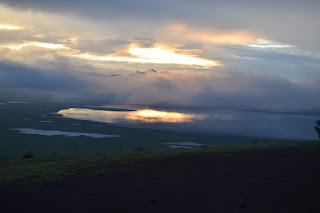We woke up at 5:30 this morning so that we could get an early start on
our game drive in the Ngorongoro Crater. Hot bottles of tea and coffee
were brought to our room, along with some small cookies to tide us over
until our breakfast down in the crater.
It was not yet sunrise at 6 AM when headed out in our safari vehicle toward the floor of the crater, driven by Paul.

The crater is the caldera left behind by the eruption of a giant volcano two million years ago, It5 is roughly a circle, roughly 100 miles square miles, with the floor being roughly 500 meters below the rim. The walls are fairly steep, so much so, Paul told us, that giraffe cannot easily navigate them to enter the crater. That, in addition to the relative paucity of acacia trees on the floor, is why giraffe are the one major African mammal that we would not see down in the crater. Rhino, however, ARE found in the crater and they rhino may walk up the crater walls to find euphorbia tree, against which they can rub despite the poisonous character of the sap
The floor of the crater is accessed by only six roads, each of them one-way up or one-way down. Although Entamamu is a long bumpy road from the rim road, its entrance to the rim road is very close to the Seneto Descent Road on the western wall off the crater. We could see a reflection of the sun breaking out on the horizon, albeit hidden from us by the clouds. as we drove down the descent road.
We could see a large cluster of buffalo on the crater bottom
as well as this small group of gazelle as we reached the crater floor
but our guide noted a group of 30 to 40 hyenas running
So we set off to see what might have caused that.






























